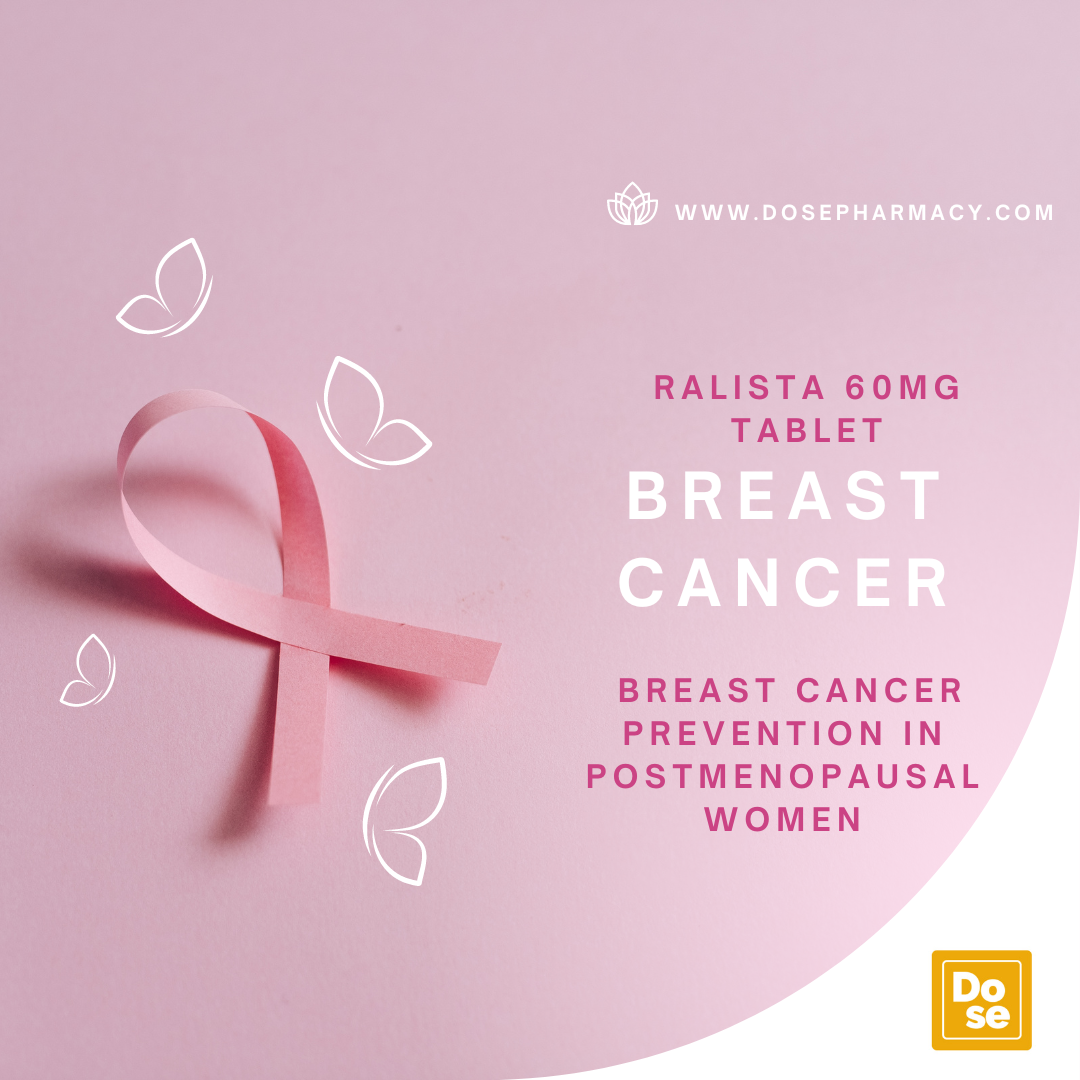Breast cancer is a major concern for many women, particularly those at higher risk due to factors like genetics, age, or hormone-related conditions. While regular screening and early detection play crucial roles in managing this disease, certain medications have emerged as preventive options. One such drug is Raloxifene 60 mg tablet. Originally developed to treat osteoporosis, Raloxifene has shown significant promise in reducing the risk of breast cancer, particularly in postmenopausal women. In this article, we’ll explore how Raloxifene works, its benefits, side effects, and the scientific evidence supporting its use as a protective measure against breast cancer.
What Is Raloxifene?
Raloxifene belongs to a class of drugs known as Selective Estrogen Receptor Modulators (SERMs). SERMs are unique because they can either block or mimic estrogen’s effects in different tissues. Estrogen plays a critical role in the growth and development of breast tissue, and in some cases, it can fuel the growth of breast cancer cells. Raloxifene helps by acting as an estrogen antagonist in breast tissue, effectively blocking the hormone’s potentially harmful influence, while still promoting bone health by mimicking estrogen’s positive effects in bones.
The Role of Estrogen in Breast Cancer
Before diving into how Raloxifene helps reduce breast cancer risk, it’s essential to understand estrogen’s role in breast cancer development. Estrogen, a hormone produced primarily by the ovaries, plays a significant role in female reproductive health. However, it can also contribute to the development and progression of hormone receptor-positive breast cancer, the most common type of breast cancer.
In hormone receptor-positive breast cancer, estrogen binds to estrogen receptors on breast cancer cells, fueling their growth and division. This is where Raloxifene steps in—by blocking estrogen’s access to these receptors, the drug can help prevent the growth of these cancerous cells.
How Raloxifene Works to Prevent Breast Cancer
Raloxifene works by binding to estrogen receptors in breast tissue, preventing estrogen from attaching to these cells. This action blocks estrogen’s cancer-promoting effects without reducing the beneficial impact of estrogen on bones and other parts of the body. Here’s a closer look at how it works:
- Estrogen Receptor Blockade in Breast Tissue
- By acting as an estrogen blocker specifically in breast tissue, Raloxifene prevents the hormone from stimulating the growth of potentially cancerous cells. This is particularly helpful for postmenopausal women, who may still have circulating estrogen even after the ovaries have stopped producing the hormone.
- Reducing Hormonal Influence
- By limiting estrogen’s interaction with breast cells, Raloxifene effectively cuts down one of the key factors that could lead to breast cancer development. This mechanism is particularly effective in hormone receptor-positive breast cancers, where estrogen directly fuels cancer growth.
- Preventing New Cancer Formation
- Research has shown that Raloxifene can prevent the formation of new breast cancer cells in high-risk postmenopausal women. This is critical in lowering the overall risk of developing breast cancer over time, making it a powerful tool in cancer prevention strategies.
Clinical Evidence Supporting Raloxifene’s Use in Breast Cancer Prevention
Several clinical trials have demonstrated the effectiveness of Raloxifene in reducing the risk of breast cancer. One of the most well-known studies is the STAR trial (Study of Tamoxifen and Raloxifene), which compared the two drugs in preventing breast cancer in postmenopausal women. The study found that:
- Raloxifene reduced the risk of invasive breast cancer by about 50% in women at high risk.
- Its efficacy in reducing breast cancer risk was similar to that of Tamoxifen, another well-established SERM.
- Raloxifene had fewer serious side effects, such as blood clots and uterine cancer, making it a safer option for some women.
The STAR trial was a pivotal study in establishing Raloxifene as an effective breast cancer preventive treatment for postmenopausal women, particularly those with osteoporosis or a high risk of breast cancer.
Who Should Consider Raloxifene for Breast Cancer Prevention?
Raloxifene is typically prescribed for postmenopausal women who have a higher-than-average risk of developing breast cancer. Factors that may make someone a candidate for Raloxifene include:
- Family history of breast cancer: Women with close relatives who have had breast cancer may be at higher risk.
- Personal history of benign breast conditions: Certain non-cancerous breast conditions can increase the risk of developing cancer later.
- Age: Older women, particularly postmenopausal women, are at higher risk for breast cancer.
- Osteoporosis: Since Raloxifene also treats osteoporosis, women who need both bone health support and breast cancer risk reduction may benefit.
It’s important to note that Raloxifene is not for everyone. Women who have not yet gone through menopause, or who have a history of blood clots, may not be suitable candidates for the drug. It’s crucial to consult with a healthcare provider to assess personal risk factors and determine if Raloxifene is an appropriate preventive treatment.
Benefits Beyond Breast Cancer Prevention
In addition to lowering breast cancer risk, Raloxifene has other health benefits:
- Bone Health: Raloxifene is approved for the prevention and treatment of osteoporosis in postmenopausal women. By mimicking estrogen’s effects on bones, it helps increase bone density and reduce the risk of fractures.
- Heart Health: While Buy Raloxifene impact on cardiovascular health is still being studied, some evidence suggests it may help reduce cholesterol levels, which could contribute to heart disease prevention.
Potential Side Effects of Raloxifene
Like all medications, Raloxifene is not without side effects. However, most side effects are mild and manageable. Some of the more common side effects include:
- Hot flashes: Since Raloxifene blocks estrogen, some women experience hot flashes, similar to those caused by menopause.
- Leg cramps: Muscle cramps, particularly in the legs, are a common side effect.
- Increased risk of blood clots: Although Raloxifene is considered safer than Tamoxifen in this regard, there is still a slightly increased risk of blood clots, including deep vein thrombosis and pulmonary embolism.
Women with a history of blood clots or those at risk should discuss this concern with their healthcare provider before starting Raloxifene.
Is Raloxifene Right for You?
Deciding whether Raloxifene is the right preventive measure for you is a decision that should be made in consultation with your healthcare provider. Together, you’ll need to consider your individual risk factors for breast cancer, your bone health, and any other health conditions you may have.
For women at high risk of breast cancer, especially those who are postmenopausal and concerned about bone health, Ralista 60mg Tablet offers a dual benefit. It’s a valuable option for reducing breast cancer risk while also strengthening bones, making it a unique and versatile treatment.
Conclusion
Ralista 60mg Tablet represents an important advancement in breast cancer prevention, particularly for postmenopausal women at high risk. By blocking estrogen’s effects on breast tissue, Ralista 60mg Tablet helps to reduce the likelihood of developing invasive breast cancer. Coupled with its ability to improve bone density and its favorable safety profile compared to other SERMs, Ralista 60mg Tablet stands out as a strong option for women seeking to protect both their breast and bone health. If you’re concerned about breast cancer or osteoporosis, it’s worth discussing with your doctor whether Ralista 60mg Tablet could be the right choice for you.



